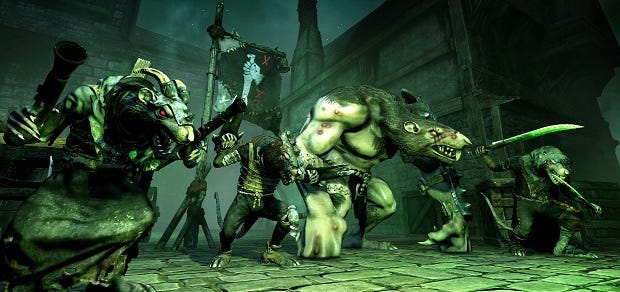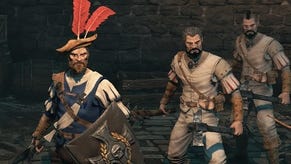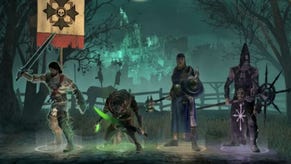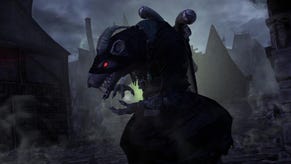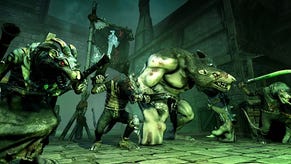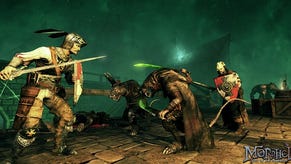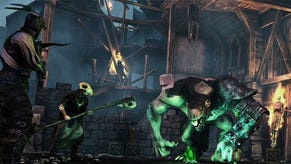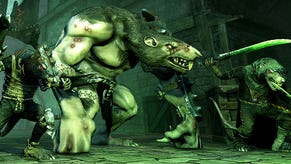Eyes-On: Mordheim – City of the Damned
That's so Skaven
A warlock with a wooden leg was the highlight of my first day at Gamescom. I didn’t know a huge amount about Mordheim: City of the Damned before I sat down to watch a live demonstration of a typical mission, but half an hour later I was telling anyone who would listen that it deserved far more attention. It’s Warhammer Fantasy with a hint of XCOM, procedural maps and the kind of persistent injuries that require false limbs. If it shapes up even half as good as it looks, it might be one of the best Games Workshop digital adaptations to date.
Mordheim: City of the Damned was one of the most pleasant surprises of Gamescom, nestled as it was between a fistful of salt-encrusted fries from the Koelnmesse’s cavernous food hall and a torrential downpour that made a mockery of my packing for the trip, which was light in every way possible. Based on a Games Workshop tabletop construction that hasn’t been receiving official support/updates for several years now, Mordheim is a squad-level turn-based tactical combat game about scrappy little warbands taking on the forces of chaos in a shattered city, while beating the blazes out of one another.
The backstory is a pleasing blend of mad cults, oozing chaos and fancy parties. The latter are all in the past, with Mordheim having been smashed to bits by a comet, but traces of the old decadence survive among the rubble and ruin. The people of the Old World’s capital believed they had been chosen by the god Sigmar when a comet blazed in the sky above and they celebrated that divine recognition by having a booze-up, which was rudely interrupted by the arrival of the Wyrdstone comet.
Now, warbands made up of courageous and/or crazed bastards travel to Mordheim to gather precious Wyrdstone shards, which are scattered through the city. Conveniently, this provides the perfect backdrop for a multi-layered campaign of team management, exploration and combat. Handy how these things tend to work out, eh?
To begin a campaign, players create a warband. Initially, there will be a choice of four factions, although more will be added based on player feedback and Games Workshop’s willingness to allow implementation of their precious creations. One of the factions already has a completely new unit available for selection, which marks the first of several changes to the ruleset of the original game.
The biggest difference may well be the method of control. At first, watching a one-versus-one developer playthrough of a procedurally generated portion of Mordheim’s Noble Quarter, I wasn’t sure how ‘turns’ worked. Units are controlled in real-time, although in order of initiative, meaning that only one is ever active. But rather than dividing the randomised maps into hexy tiles, developers Rogue Factor have opted for continuous spaces that characters move through from a third-person view.
Limits to activity come in the form of movement and action points. A movement point is used up whenever a character climbs a piece of terrain or jumps down to another level, as well as running around the map. At the beginning of a turn, the game calculates range by projecting circles around the character – move beyond the limits of one circle and one movement point evaporates. This means the range of possible motion is clear and the tactical placement of units is vital, but also provides a sense of fluidity when setting up ambushes and exploring.
Maps contain traps and become increasingly dangerous as a warband travels toward the city’s centre, but the real enemy comes in the form of other warbands. These can be either human-controlled or AI, the latter during the campaign, which involves personnel management and is responsible for the warlock and his pegleg.
Each character is unique, drawn from a faction-specific pool of classes. For the newly revealed Cult of the Possessed, that pool includes hopeful necromantics, undead and enormous great demon-beasts. For the human mercenaries, there’s a more prosaic mix, although the special troop is a stinking great ogre wearing full-sized human shields as wrist-guards. The Sisters of Sigmar are the faction with a newly created unit, although nobody is sharing details at the moment.
The final faction are Skaven, which immediately increases Mordheim’s chances of being one of the RPS chosen. Chosen it might be but we promise not to lob a comet at it even if it does become unbearably self-important, throw itself a party and get boozed up on adults-only fizz before falling to sleep and drooling all over the newly upholstered Louis XV (a man, not a chair). At this early stage (pre-alpha), Mordheim has oodles of promise but best not to get too excited until I play it for myself.
That said, it is a bit like Warhammer XCOM with peglegs. Characters are hired, equipped and levelled up as they survive missions. Anyone ‘knocked down’ during a mission is out for the duration but their ultimate fate isn’t decided until the battle is won or lost. The roll of a die decides whether they live or die, and if they DO survive, a table of results provides them with a permanent injury. This can involve decreased stats due to broken bones or scarring, which is all well and good, but it’s the eye and limb loss that is of particular interest.
Yes, it’s horribly morbid, but the characters are chunky Warhammer characters with more than a hint of strange comedy around them. And if they do lose a leg, you can always pop a wooden one on. Nothing too complicated but it adds such character – the ultimate sign of a veteran warrior, dragging his false limb across a blood-stained battlefield. Or maybe the mark of a hapless fool, walking on wood because he walked into an ambush during his first day on the job. Such details as eyepatches and peglegs can be the making of a man.
Customisation is key to the design of warbands. Gear and colour schemes can be edited, and in an attempt to emulate my grotesque teenage attempts at modelling, armour sets can be mixed and matched. Fancy a captain with one lightly armoured arm on the right while his left hand protrudes from a monstrous casing of plate mail? It can be done. Character development also takes the form of skill selection, with various abilities unlocked and available for each class, including initiative-boosting support skills for the captain and crippling knee shots for archers.
For tactical variety, each unit has two weapon sets available and in the mission I saw, this allowed for a team of four to operate intelligently, despite their limited numbers, reacting to threats real and imagined rather than simply blundering across the map and hoping to bruteforce their way to victory thanks to superior stats. Because players can only see what their characters can see, ambushes and control of space will be important. Added to that, there’s a tension in every action – the chance of success is displayed and failure can lead to exposure, stasis or worse. Firearms seem likely to backfire and spells that fizzle might cause the caster to sizzle.
After I saw the game, I wanted to play the game and now I’m annoyed that I can’t until it arrives in either Early Access (official, capitalised, steamy) or early access (a playable alpha/beta) later this year. If I had a copy, it’s the game I’d be playing right now, which is high praise indeed considering that in the week following Gamescom I don’t usually want to play any games at all. Too many to write about and too many thoughts to gather.
The campaign may not be as deep as I hope – although procedural levels and persistent characters sound like the right building blocks – but Mordheim looks a lot like Warhammer XCOM, with a few tricks of its own concealed in the sleeve and the tattered trouser cuff. It’s appeal is strong and I hope to see more of it soon.
